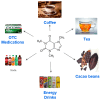Caffeine: A Neuroprotectant and Neurotoxin in Traumatic Brain Injury (TBI)
- PMID: 40507194
- PMCID: PMC12157813
- DOI: 10.3390/nu17111925
Caffeine: A Neuroprotectant and Neurotoxin in Traumatic Brain Injury (TBI)
Abstract
Caffeine is a weak, nonselective adenosine receptor antagonist. At low-to-moderate doses, caffeine has a stimulating effect; however, at higher doses, it can act as a depressant. It can function both as a neuroprotectant and a neurotoxin. In experimental Traumatic Brain Injury (TBI), administration of this psychoactive drug has been associated with beneficial or detrimental effects, depending on the dose, model, and timing. In a healthy brain, caffeine can enhance alertness and promote wakefulness. However, its consumption during late adolescence and early adulthood disrupts normal pruning processes in the context of repetitive moderate TBI (mTBI), leading to changes in dendritic spine morphology, resulting in neurological and behavioral impairments. Caffeine can potentially reduce TBI-associated intracranial pressure, oxidative stress, lipid peroxidation, cytotoxic edema, inflammation, and apoptosis. It can enhance alertness and reduce mental fatigue, which is critical for the cognitive rehabilitation of TBI patients. Additionally, caffeine positively affects immune cells and aids recovery post-TBI. Antagonizing adenosine receptors involved in controlling synaptic transmission, synaptic plasticity, and synapse toxicity can improve cognitive function. Conversely, studies have also shown that caffeine consumers report significantly higher somatic discomfort compared to non-consumers. This review aims to explore various studies and thoroughly examine the positive and negative roles of caffeine in TBI.
Keywords: Traumatic Brain Injury; blunt trauma; caffeine; clinical outcomes; neuroprotectant; neurotoxin; penetrating trauma.
Conflict of interest statement
The authors declare no conflict of interest.
Figures


References
-
- Richard G., Ellenbogen L.N., Sekhar H.B.S. Principles of Neurological Surgery. 4th ed. Elsevier; New York, NY, USA: 2017.
-
- Lerner J.T., Giza C.C. Swaiman’s Pediatric Neurology. Elsevier; New York, NY, USA: 2012. Traumatic Brain Injury in Children; pp. 1087–1125. - DOI
Publication types
MeSH terms
Substances
LinkOut - more resources
Full Text Sources
Medical

